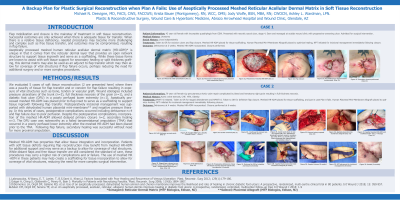Clinical Research
(CR-022) A Backup Plan for Plastic Surgical Reconstruction When Plan a Fails: Use of Aseptically Processed Meshed Reticular Acellular Dermal Matrix in Soft Tissue Reconstruction

Flap mobilization and closure is the mainstay of treatment in soft tissue reconstruction. Successful outcomes are only achieved when there is adequate tissue for transfer. When there is a relative tissue deficiency, needed procedures may become more challenging and complex such as free tissue transfer, and outcomes may be compromised, resulting in flap failure.
Aseptically processed meshed human reticular acellular dermal matrix (HR-ADM) is unique in that it comes from the reticular dermal layer that provides an open network structure to support tissue ingrowth and serve as a scaffolding. While these tissue forms are known to assist with soft tissue support for secondary healing or split thickness grafting, this dermal matrix may also be used as an adjunct to flap transfer which may then allow for coverage of vital structures if flap failure occurs, perhaps reducing the need for additional surgery and or more complex procedures.
Methods: We present 5 cases of soft tissue reconstruction where there was a paucity of tissue and or concern for flap failure resulting in exposure of vital structures such as bone, tendon or vascular graft. Wound etiologies included Pressure ulcerations n=3, Full thickness necrosis of the groin n=1, and a Diabetic foot ulcer (DFU) in a poorly perfused lower extremity n=1). Aseptically processed meshed HR-ADM was placed prior to flap inset to serve as a scaffolding to support tissue ingrowth following flap transfer.
Results: Postoperative complications occurred including dehiscence n=4 and flap failure. Despite the complications, incorporation of the meshed HR-ADM allowed delayed primary closure n=2, secondary healing n=3. The DFU case was noteworthy as a failed tarsometatarsal amputation (TMA) that occurred in a poorly perfused lower extremity after the meshed HR-ADM had been placed prior to the TMA. Following flap failure, secondary healing was successful without need for more proximal amputation.
Discussion:
Meshed HR-ADM has properties that allow tissue integration and incorporation. Patients with soft tissue deficits requiring flap reconstruction may benefit from meshed HR-ADM for additional support and may serve as a backup to allow for coverage of vital structures. While distant flaps are still considered the standard of care, these procedures may carry a higher risk of complications. The use of meshed HR-ADM in these patients may help create a scaffolding for tissue incorporation to allow for coverage of vital structures, reducing the need for more complex surgical intervention.

.jpg)